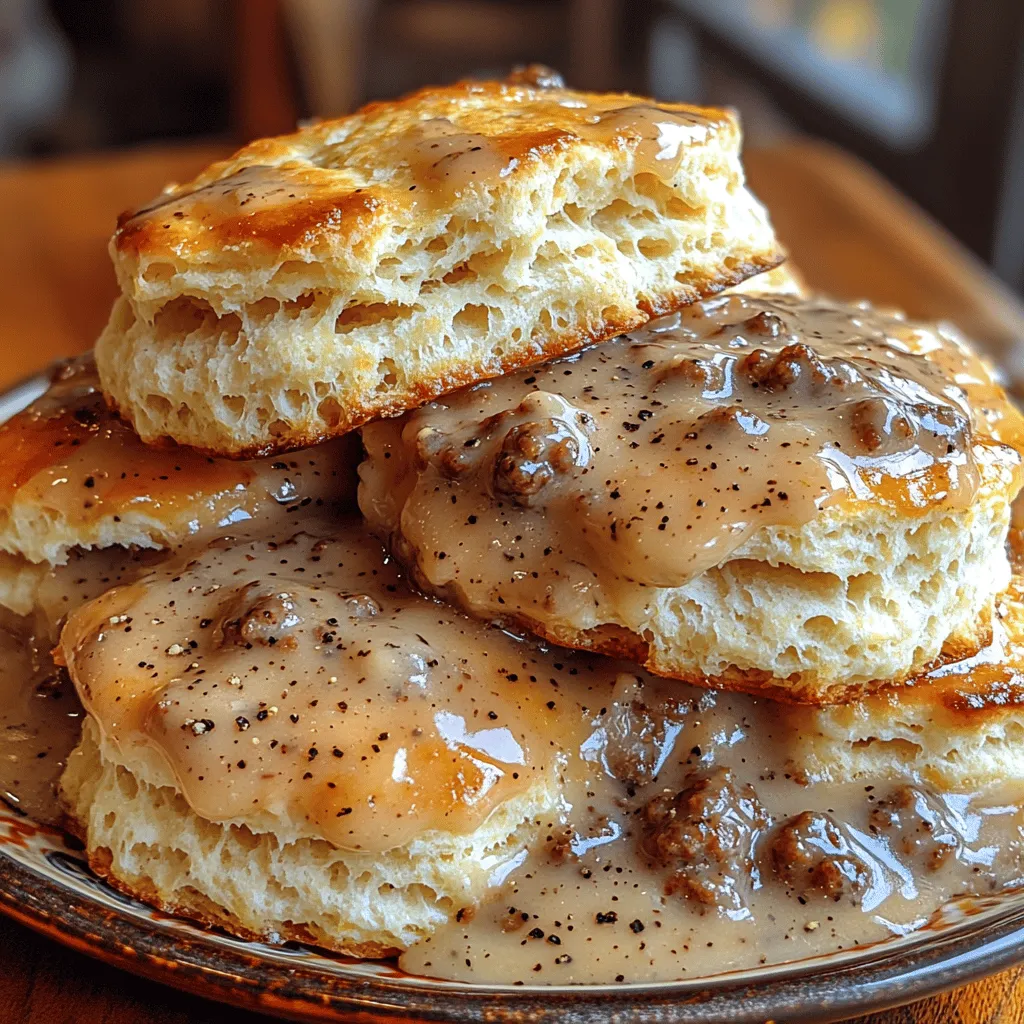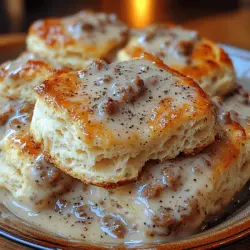When it comes to comfort food, few dishes evoke the warmth and nostalgia of homemade buttermilk biscuits smothered in savory sausage gravy. This delightful combination is not just a meal; it’s a heartfelt experience that has become a staple in Southern cuisine and beloved by food enthusiasts across the country. The allure of fluffy, buttery biscuits paired with rich, creamy gravy makes this dish a favorite at breakfast tables and brunch gatherings alike. Whether you’re enjoying them on a lazy Sunday morning or serving them up for family and friends, these biscuits and gravy are sure to satisfy.
The Comfort Food Factor
In the realm of comfort food, biscuits and gravy stand out for their simplicity and heartwarming flavors. The rich, velvety gravy enveloping tender, flaky biscuits creates a symphony of textures and tastes that makes each bite feel like a warm hug. The dish is not only a testament to Southern culinary traditions but also a reminder of family gatherings and cherished moments spent around the breakfast table. The aroma of freshly baked biscuits wafting through the kitchen is enough to make anyone feel at home.
The Significance in Southern Cuisine
Homemade biscuits and gravy hold a special place in Southern cuisine. Historically, biscuits were a practical staple, made with simple ingredients that were readily available. As the South embraced the art of cooking, biscuits evolved into a beloved dish that showcases the region’s culinary prowess. The combination of buttermilk biscuits and sausage gravy reflects the resourcefulness and creativity of Southern home cooks, who turned basic ingredients into delicious meals that bring people together.
Understanding the Ingredients
To create the perfect Heavenly Fluffy Buttermilk Biscuits with Irresistible Sausage Gravy, it’s essential to understand the key ingredients that contribute to the dish’s unique texture and flavor.
Key Components of Fluffy Buttermilk Biscuits
1. Flour and Leavening Agents: The foundation of any biscuit is flour, which provides structure. For the best results, use all-purpose flour that has a moderate protein content to maintain the perfect balance between tenderness and structure. Leavening agents, specifically baking powder and baking soda, play a crucial role in achieving the biscuits’ light and airy texture. Baking powder creates bubbles of carbon dioxide when it comes into contact with moisture and heat, while baking soda requires an acidic ingredient, such as buttermilk, to activate its leavening properties.
2. Cold Butter: The texture of the biscuits is significantly influenced by the use of cold butter. When cold butter is cut into the flour, it creates small pockets of fat that melt during baking, resulting in flaky layers. The key is to handle the butter as little as possible, keeping it chilled until it’s time to mix it into the dry ingredients.
3. Buttermilk: Buttermilk is the secret ingredient that adds both moisture and flavor to biscuits. The acidity in buttermilk not only tenderizes the dough but also enhances the overall taste, giving the biscuits a slight tang that perfectly complements the richness of the butter. Additionally, buttermilk interacts with baking soda to create a beautifully fluffy texture.
Exploring Sausage Gravy
Sausage gravy is the perfect companion to buttermilk biscuits, transforming a simple dish into a hearty meal. The choice of sausage and the way it’s prepared can drastically change the flavor profile of the gravy.
1. Types of Breakfast Sausage: There are various types of breakfast sausage available, ranging from mild to spicy. Choosing the right sausage is essential, as it determines the overall taste of the gravy. Mild sausage offers a subtle flavor, while hot sausage introduces a delightful kick. For a well-rounded gravy, consider mixing both types to achieve your desired spice level.
2. Thickening the Gravy: The gravy’s creaminess comes from a roux made by cooking flour in the rendered fat from the sausage. This mixture thickens the gravy as it simmers, creating a luscious sauce that clings to the biscuits. The right consistency is key—too thin, and it won’t coat the biscuits well; too thick, and it risks becoming gloopy.
3. Spices for Flavor Enhancement: While the sausage provides a robust base, a blend of spices elevates the flavor of the gravy. Black pepper is a must, delivering a subtle heat that enhances the savory notes. Garlic powder and onion powder add depth, creating a well-rounded flavor profile that perfectly complements the richness of the sausage.
Step-by-Step Guide to Making Fluffy Buttermilk Biscuits
Now that we’ve covered the essential ingredients, let’s dive into the process of making these heavenly biscuits. Follow this step-by-step guide to ensure your biscuits turn out perfectly fluffy and delicious.
Preparing the Oven and Baking Sheet
Before you start mixing the dough, it’s crucial to prepare your baking environment. Preheat your oven to 425°F (220°C). A hot oven is essential for creating the steam needed to help the biscuits rise. While the oven is heating, line a baking sheet with parchment paper. This prevents the biscuits from sticking and aids in even cooking, ensuring a golden-brown bottom.
Creating the Biscuit Dough
1. Mixing the Dry Ingredients: In a large mixing bowl, combine the all-purpose flour, baking powder, baking soda, and salt. Whisk these dry ingredients together to ensure they are evenly distributed. This step is vital, as it helps to create a uniform texture in the biscuits.
2. Incorporating the Cold Butter: Next, take your cold butter and cut it into small cubes. Add the butter to the flour mixture. Using a pastry cutter or your fingertips, work the butter into the flour until the mixture resembles coarse crumbs. Be careful not to overwork the dough; you want to see small pieces of butter still visible, as these will create the flaky layers once baked.
3. Adding Buttermilk: Pour in the cold buttermilk, gently stirring until the mixture just comes together. It’s important to mix only until combined. Overmixing can lead to tough biscuits, so stop as soon as you no longer see dry flour.
Shaping the Biscuits
1. Folding the Dough: Turn the dough out onto a lightly floured surface. Gently pat it into a rectangle about one inch thick. To create more layers, fold the dough over onto itself in thirds, similar to folding a letter. This technique helps to create the signature flaky texture.
2. Cutting the Biscuits: Using a floured biscuit cutter, cut out rounds from the dough. To ensure the biscuits rise well, avoid twisting the cutter when pressing down, as this seals the edges. Instead, press straight down and lift the cutter straight up.
3. Arranging on the Baking Sheet: Place the biscuits on the prepared baking sheet, with their sides touching. This helps them rise higher and creates a soft, tender side on each biscuit.
Baking to Perfection
Once your biscuits are shaped and arranged on the baking sheet, it’s time to bake them to golden perfection. Place the baking sheet in the preheated oven and bake for 12 to 15 minutes, or until the tops are golden brown. Keep a close eye on them, as baking times may vary based on your oven. The aroma of freshly baked biscuits will fill your kitchen, making it nearly impossible to resist.
With these foundational steps, you are well on your way to creating magnificent buttermilk biscuits that will serve as the perfect base for your irresistible sausage gravy. In the next section, we will dive into the delightful process of making the gravy that will transform your biscuits into a truly heavenly meal.

Importance of Brushing with Buttermilk for Golden Color
Brushing your freshly baked biscuits with buttermilk before they go into the oven is a crucial step that elevates their appearance and taste. This simple technique not only enhances the biscuits’ golden-brown color, creating an irresistible visual appeal, but it also adds a subtle richness to the crust. The natural fats present in the buttermilk help to create a beautifully crisp exterior while retaining a soft, tender interior. This brings out the best in the fluffy texture of the biscuits, making them all the more delightful when served warm.
How to Tell When Biscuits Are Done
Knowing when your biscuits are perfectly baked can be the difference between a heavenly treat and a disappointment. As a general rule, your biscuits should be golden brown on top, with a slightly crisp exterior. You can gently tap the side of a biscuit; if it sounds hollow, that’s a good indication they are done. Additionally, the internal temperature should ideally reach around 190°F (88°C) for optimal fluffiness. If you’re unsure, don’t hesitate to check with a toothpick; it should come out clean or with just a few crumbs attached.
Crafting the Perfect Sausage Gravy
Cooking the Sausage
Creating a rich and flavorful sausage gravy starts with the right sausage. Use high-quality breakfast sausage for the best results, as the flavor of the meat is central to the dish. In a large skillet over medium heat, crumble the sausage into the pan. Use a wooden spoon to break it apart as it cooks, ensuring even browning. This process not only enhances the flavor but also allows the sausage to render its fat, which is essential for the gravy.
Tips for Crumbling and Browning Sausage Properly
To achieve perfectly crumbled sausage, begin with the sausage at room temperature. This allows it to break apart more easily. As you cook, stir occasionally to ensure even browning. Avoid overcrowding the pan; if necessary, cook in batches. A good browning process will create those delicious bits stuck to the bottom of the pan, which will later contribute to the depth of flavor in your gravy.
Managing Grease for the Ideal Texture
Once your sausage is fully cooked and browned, it’s important to manage the grease. Depending on your sausage, you may have excess fat in the pan. For a less greasy gravy, consider draining some of the fat, leaving about 2 tablespoons in the pan for flavor. This balance is key; too much grease can lead to a heavy, oily gravy, while too little will make it dry.
Making the Gravy
With the sausage cooked and the grease managed, it’s time to transform that golden fat into a luscious gravy.
1. Add Flour: Sprinkle about 1/4 cup of all-purpose flour over the cooked sausage. Stir immediately to coat the sausage evenly, cooking for about 1-2 minutes to eliminate the raw flour taste. This step is essential for thickening the gravy.
2. Gradually Add Milk: Slowly pour in 2 cups of milk, whisking continuously to prevent lumps from forming. The key is to add the milk gradually, allowing it to incorporate smoothly before adding more.
3. Thicken the Gravy: Continue to cook the mixture, stirring frequently, until it thickens to your desired consistency. This usually takes about 5-7 minutes. If the gravy becomes too thick, you can add a splash of milk to loosen it.
Techniques to Achieve a Smooth, Lump-Free Gravy
To avoid any lumps in your gravy, ensure that you whisk continuously as you add the milk. If you do find lumps forming, a quick fix is to use an immersion blender to blend the gravy until smooth. Alternatively, you can transfer the gravy to a regular blender and pulse it until it reaches the desired consistency.
Flavor Adjustments
Once your gravy is thick and smooth, it’s time to enhance its flavor. A pinch of salt and pepper is essential, but you can also experiment with additional spices. Consider adding a dash of garlic powder, onion powder, or even a sprinkle of cayenne pepper for a bit of heat. Fresh herbs like thyme or sage can also impart a lovely aroma and depth of flavor. Don’t forget to taste and adjust the seasoning as needed to ensure the gravy is just right for your palate.
Serving Suggestions
Presentation Ideas
When serving your biscuits and gravy, presentation matters. Start by placing a warm biscuit on a plate and ladle a generous portion of sausage gravy over it. For visual appeal, consider stacking two biscuits and topping them with gravy. A sprinkle of fresh herbs, such as chopped parsley or chives, adds a vibrant touch and a pop of color to your dish.
Additional Toppings or Garnishes
Enhance your dish with optional toppings that can elevate the flavor and aesthetics. Crumbled crispy bacon, a drizzle of hot sauce, or even a fried egg on top can add extra layers of flavor and richness. These thoughtful additions make the dish not only more visually appealing but also more satisfying.
Pairing Ideas
For a complete meal, consider pairing your biscuits and gravy with some side dishes. A simple side of fresh fruit, such as sliced strawberries or a mixed berry salad, can add a refreshing contrast. If you prefer something heartier, a side of sautéed greens or hash browns can round out the meal beautifully. For beverages, a classic choice would be freshly brewed coffee or a creamy latte, but a glass of freshly squeezed orange juice can also provide a delightful sweetness alongside the savory biscuits.
Nutritional Information
When it comes to enjoying comfort food, it’s good to be mindful of nutritional content. A typical serving of biscuits and gravy (one biscuit with gravy) can range from 400 to 600 calories, depending on the ingredients used and portion sizes.
Overview of the Nutritional Content per Serving
– Calories: Approximately 500 calories
– Fat: 30g (saturated fat from sausage and buttermilk)
– Carbohydrates: 45g (from biscuits)
– Protein: 15g (mainly from sausage and buttermilk)
Discussion on Calorie Counts and Dietary Considerations
For those watching their calorie intake, consider using lower-fat sausage options, skim milk, or whole wheat flour to make the biscuits. You can also reduce the portion size or enjoy biscuits and gravy as an occasional treat rather than an everyday meal.
Conclusion
There’s something profoundly comforting about homemade biscuits and gravy. The heavenly fluffiness of the buttermilk biscuits paired with the rich, savory sausage gravy creates a dish that is not only delicious but also reminiscent of cozy family gatherings and weekend brunches.
As you gather around the table with loved ones, this dish becomes more than just a meal; it’s an experience filled with warmth, laughter, and satisfaction. So, roll up your sleeves and give this recipe a try. Whether it’s for a special occasion or just because, making biscuits and gravy from scratch will undoubtedly bring joy to your kitchen and delight to your dining table. The joy of cooking and sharing such a beloved recipe is truly a reward in itself. Happy cooking!


